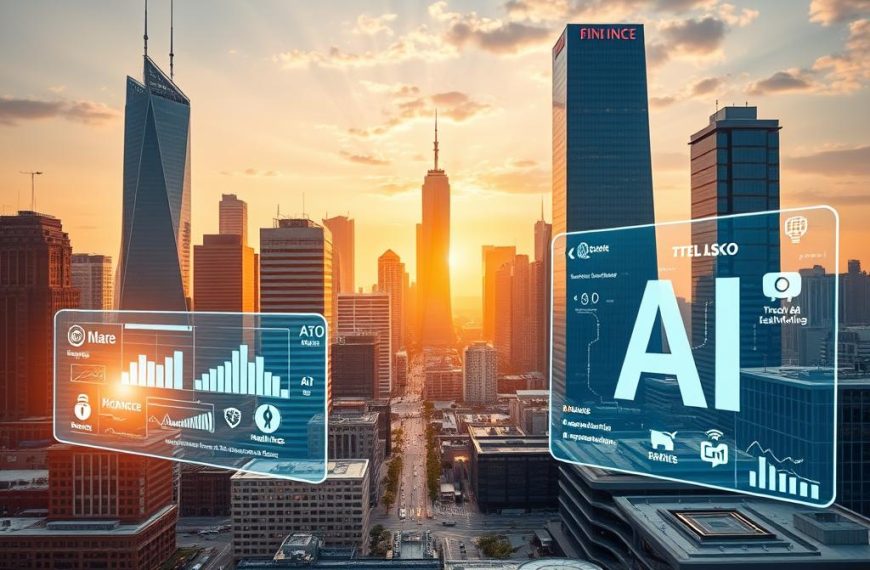Artificial intelligence is transforming modern enterprises by automating tasks and unlocking data-driven insights. From chatbots to predictive analytics, this technology reshapes how companies operate and engage with customers.
Business leaders recognize its potential—87% plan to increase investments in AI and machine learning tools. These innovations boost productivity across departments, including customer service, HR, and supply chain management.
Real-world applications like Samsung’s Galaxy S24 Ultra and Microsoft’s OpenAI partnership showcase AI’s impact. It streamlines workflows, enhances decision-making, and personalizes customer interactions at scale.
With 63% of companies expanding AI adoption, understanding its capabilities is no longer optional. This technology drives efficiency, reduces costs, and creates competitive advantages in fast-moving industries.
What Does AI Mean in Business?
Modern enterprises leverage artificial intelligence to redefine operational efficiency and customer interactions. This technology combines machine learning (ML), natural language processing (NLP), and neural networks to mimic human intelligence at scale.
| Weak AI | Strong AI |
|---|---|
| Task-specific (e.g., chatbots) | Theoretical general intelligence (AGI) |
| Mastercard’s real-time fraud detection | Not yet realized commercially |
ML algorithms excel at pattern recognition, enabling predictive analytics. For example, Unilever’s recruitment systems use AI to reduce bias, analyzing candidate data objectively.
71% of employees trust their employers to use AI ethically.
NLP powers sentiment analysis, while neural networks replicate brain-like decision-making. Deep learning, a subset of ML, drives image and text recognition—key for industries like retail and healthcare.
These applications underscore AI’s transformative potential. From automating workflows to enhancing security, businesses harness its capabilities for sustainable growth.
Key Benefits of AI for Businesses
Companies adopting intelligent systems see measurable improvements in operations and customer interactions. These technologies deliver faster responses, deeper insights, and tailored experiences—critical advantages in competitive markets.
Enhanced Customer Engagement
Chatbots streamline customer service, handling 68% of inquiries without human intervention. Brands like KFC China use mood-detection tools to predict orders, boosting satisfaction.
Sentiment analysis, like Sprout Social’s platform, monitors brand health in real time. Netflix-style recommendation engines personalize content, increasing engagement by *45%* in targeted campaigns.
| AI-Driven CRM | Traditional CRM |
|---|---|
| 45% higher conversions | Manual follow-ups |
| Predicts customer behavior | Limited data insights |
Data-Driven Decision Making
Heineken’s ML models forecast inventory needs, cutting waste by 15%. Automated data entry reduces errors, saving thousands of hours annually.
“Predictive analytics transform raw numbers into actionable strategies.”
Société Générale accelerated its digital strategy using AI-powered analysis, proving that efficiency and accuracy drive long-term growth.
AI Applications Across Industries
From retail to healthcare, intelligent systems now drive measurable improvements across sectors. These tools optimize workflows, reduce costs, and unlock new revenue streams. Below are three areas where adoption accelerates.
Marketing & Sales Optimization
Volkswagen’s AI-optimized ad campaigns reduced wasted spending by 20%. Tools like Gemini process multimodal data—analyzing social media, emails, and purchase history to personalize promotions.
Recommendation engines boost sales by predicting customer preferences. For example, Spotify’s algorithms increase playlist engagement by 30%. Sentiment analysis also helps brands adjust messaging in real time.
Operations & Supply Chain
Warehouse robots now achieve 99.9% picking accuracy, slashing fulfillment errors. AIOps automates 73% of IT tasks, like outage detection, freeing teams for strategic work.
Demand forecasting tools analyze inventory levels and market trends. Heineken’s models cut waste by 15%, while Tesla’s autonomous fleets optimize delivery routes using reinforcement learning.
HR & Talent Management
Sixty percent of SMBs prioritize hiring AI-skilled talent. Platforms like HireVue screen resumes 10x faster, reducing bias in recruitment. AI in business also streamlines payroll, cutting errors by 40%.
Meta Llama’s risk management tools predict attrition, while Textio refines job postings for inclusivity. These innovations prove that automation enhances human potential, replacing tasks—not roles.
AI-Powered Automation: Boosting Efficiency
Intelligent automation reshapes workplace dynamics by accelerating repetitive tasks with precision. Companies using robotic process automation (RPA) cut operational costs by 35–65%, proving its financial impact.
Traditional workflows pale in comparison. For example, AI transcribes meetings four times faster than humans, while platforms like BasicAI achieve 99% accuracy in data labeling. These systems eliminate bottlenecks, freeing teams for strategic work.
| Manual Processes | AI Automation |
|---|---|
| Prone to human error | 99.9% sorting accuracy |
| Slow meeting notes | Real-time transcription |
| High compliance risks | Automated audit trails |
Deci AI’s NVIDIA-optimized models exemplify performance gains, reducing latency by 80%. Financial firms leverage automated compliance recording to minimize errors—a critical upgrade given that manual processes caused 40% of past losses.
“AI-powered automation handles 73% of IT tasks autonomously, from outage detection to patch management.”
Despite these advantages, 67% of SMBs lack implementation plans. Early adopters, however, see AI-powered automation as a game-changer, streamlining repetitive tasks to boost overall productivity.
Ethical Considerations and Risks
As organizations integrate advanced technologies, ethical dilemmas emerge alongside efficiency gains. President Biden’s 2023 Executive Order mandates responsible development, reflecting growing scrutiny. Transparency in algorithms and data usage now determines public trust.
The IMF warns 40% of global jobs face exposure to automation. While some roles evolve, others risk displacement without upskilling programs.
“Workforce transitions require proactive policies to balance productivity with social stability,”
notes their recent report.
Bias remains a critical challenge. Carnegie Mellon research revealed gender discrimination in ad targeting, mirroring Google’s 2019 algorithm controversy. These risks underscore the need for diverse training datasets and regular audits.
| Traditional Governance | AI-Era Solutions |
|---|---|
| Annual compliance checks | Real-time bias monitoring |
| Generic data policies | Personal information (PII) encryption |
| Manual security reviews | Automated threat detection |
The EU AI Act classifies systems by risk levels, demanding strict compliance for sensitive applications. Microsoft’s Responsible Principles framework aligns with these standards, emphasizing human oversight.
MIT proposes hybrid teams where humans validate algorithmic decisions. This approach mitigates risks while leveraging machine speed. Healthcare and finance sectors already pilot these models successfully.
Forward-thinking companies establish cross-functional ethical review boards. These groups evaluate privacy safeguards, workforce impacts, and societal consequences before deployment—turning potential vulnerabilities into competitive advantages.
AI in Cybersecurity and Fraud Detection
Cyber threats evolve rapidly, but intelligent defenses now outpace them. The cybersecurity AI market will hit $38.2 billion by 2026, driven by threats like phishing and deepfakes. Neural networks analyze data streams in real time, spotting anomalies human teams miss.
Mastercard’s systems prevent scams by recognizing transaction patterns. Their algorithms flag suspicious activity—like sudden large purchases—with 94% accuracy. Darktrace’s AI responds to threats in seconds, 60x faster than manual reviews.
“Behavioral biometrics now authenticate users by typing speed and mouse movements, reducing impersonation risks.”
Advanced fraud detection tools combat deepfakes. Microsoft’s Video Authenticator analyzes facial micro-expressions to expose synthetic media. Meanwhile, AI-powered penetration testing simulates attacks to strengthen network defenses proactively.
Security Operations Centers (SOCs) automate 73% of alerts, prioritizing critical threats. These systems learn from each incident, continuously improving cybersecurity postures. As criminals innovate, algorithms adapt—turning reactive security into proactive protection.
Overcoming Implementation Challenges
While 61% of SMBs struggle with AI adoption, strategic planning turns obstacles into advantages. Microsoft’s 2024 research reveals most lack clear vision, yet structured roadmaps bridge this gap.
Start with a phased approach. Pilot projects validate ROI before scaling, minimizing risk. Cloud-based solutions like Azure AI simplify integration, avoiding costly infrastructure overhauls.
Legacy systems pose compatibility challenges. APIs and middleware connect old and new platforms. For example, Walmart unified 20+ databases using layer-based architecture.
“Upskilling programs boost adoption success rates by 40%, transforming resistance into advocacy.”
Invest in training to close skills gaps. Salesforce’s Trailhead academy certifies employees in AI tools within weeks. Change management matters equally—communicate benefits transparently to reduce friction.
Modernize data infrastructure first. Cleansing techniques standardize formats, while audits ensure compliance. Poor quality inputs cause 35% of targeting errors, per recent studies.
| Barrier | Solution |
|---|---|
| Legacy systems | API gateways |
| Low data quality | Automated validation |
| Employee resistance | Hands-on labs |
Vendor selection criteria should prioritize flexibility. Look for platforms with pre-built connectors and scalability. ROI frameworks then track performance against KPIs like process speed or cost savings.
Future Trends: The Next Wave of AI
Emerging technologies are redefining industries faster than ever before. From quantum computing to neuromorphic chips, these advancements promise to reshape workflows and applications across sectors. By 2025, agentic AI systems will autonomously manage complex tasks, boosting efficiency by 40%.
Climate tech leverages technology to optimize energy grids and predict extreme weather. For example, AI-driven models now reduce carbon footprints in logistics by 20%. NVIDIA’s generative infrastructure supports these developments, enabling real-time data processing.
Smart cities exemplify innovation. Barcelona uses AI for traffic management, cutting congestion by 30%. Similarly, AI’s economic impact is evident in healthcare, where algorithms accelerate drug discovery by 50%.
| Current Tech | Future Trends |
|---|---|
| Cloud-based AI | Edge AI deployment |
| Basic automation | Agentic AI workflows |
| General ML models | Personalized medicine |
Regulatory frameworks like the EU AI Act emphasize transparency. As trends evolve, hybrid teams—combining human oversight with machine speed—will mitigate risks while driving growth.
“Quantum computing will solve problems deemed impossible today, unlocking new frontiers.”
Neuromorphic chips mimic brain functions, enabling faster decision-making. These developments ensure AI remains a cornerstone of progress, transforming challenges into opportunities.
How to Start Leveraging AI Today
Organizations ready to embrace innovation can implement intelligent solutions with minimal upfront investment. Seventy-five percent of small business leaders already experiment with generative tools like ChatGPT, seeing 40% higher lead generation. The key lies in strategic implementation—starting small and scaling smartly.
- Identify repetitive tasks: Audit workflows for manual processes like data entry or scheduling
- Select pilot projects: Choose high-impact, low-risk applications such as content creation or customer segmentation
- Evaluate platforms: No-code options like Zapier simplify automation without technical teams
Sprout Social demonstrates successful adoption. Their AI-powered content suggestions boost engagement while saving 15 hours weekly. Similar tools from Zendesk automate 68% of customer service inquiries.
“Measure ROI through time savings and conversion lifts—not just cost reduction.”
Critical success factors include:
| Challenge | Solution |
|---|---|
| Legacy system integration | API connectors |
| Employee resistance | Hands-on training labs |
| Data quality issues | Automated validation tools |
Begin with free trials of platforms like Microsoft Copilot. These applications require minimal setup while delivering immediate efficiency gains. Document results to build organizational buy-in for broader deployment.
Remember: effective adoption combines technology with change management. Teams using structured rollout plans see 40% faster adoption rates according to Salesforce research.
Conclusion
The transformative impact of artificial intelligence reshapes industries, delivering 3X productivity gains for early adopters. Firms embracing these tools outperform competitors through automated workflows and data-driven strategies.
Ethical frameworks remain critical—84% of executives link responsible AI use to long-term growth. Governance committees ensure transparency, aligning innovation with regulatory standards.
Industry-specific transformations accelerate. Marketing teams achieve 70% time savings, while healthcare leverages precision diagnostics. Continuous learning programs empower workforces to harness evolving technology.
Track success with KPIs like cost reduction and customer satisfaction. With AI potentially adding $15.7T to global GDP by 2030, strategic planning today secures tomorrow’s competitive edge.










